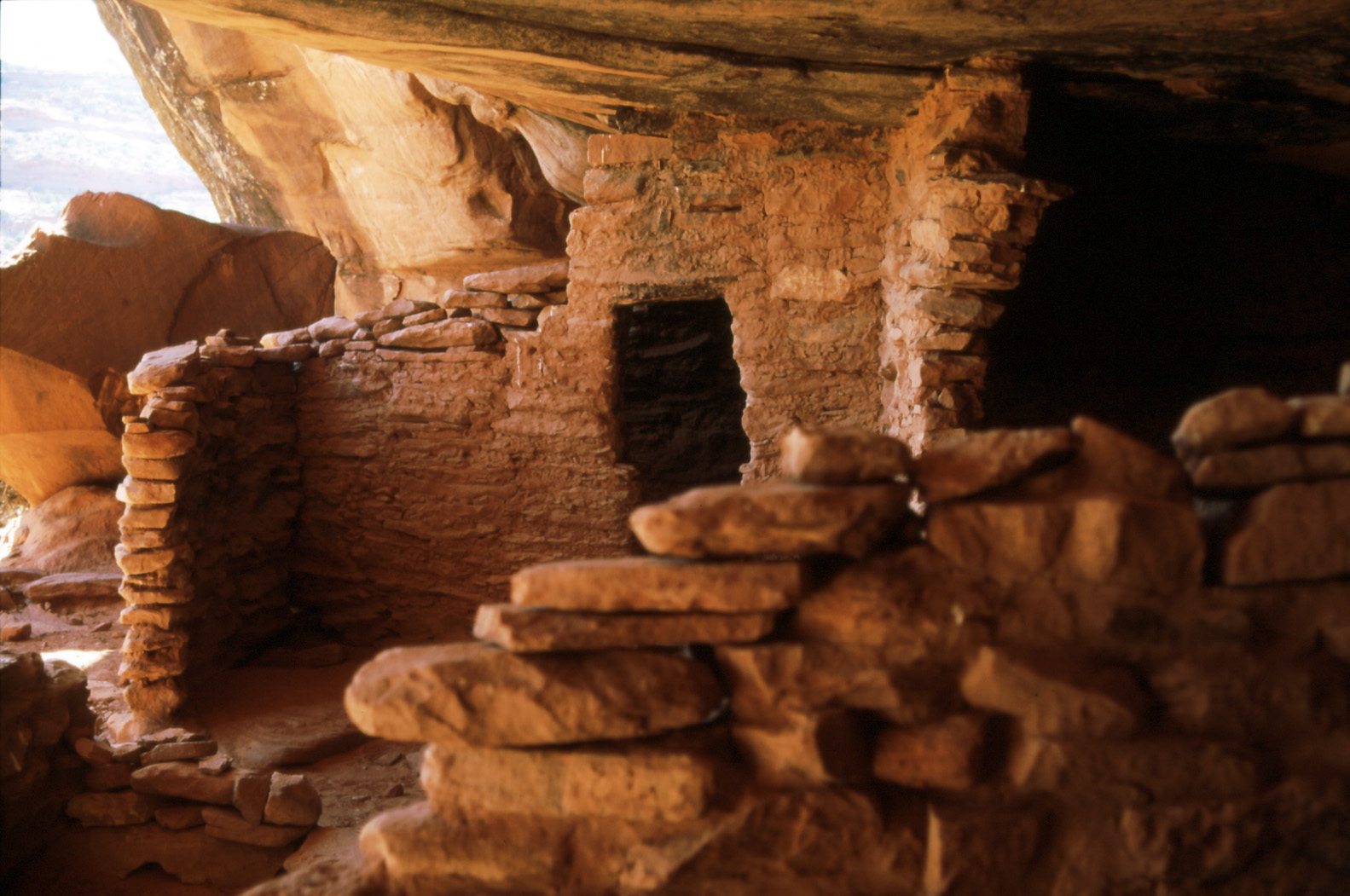 By Dave Webb
By Dave Webb
Hiding in Plain Sight
The Anasazi of Glen Canyon
Green Water Ruin
One of my favorite Anasazi (Ancestral Puebloan) ruins is located along Hyw 276, just southeast of Halls Crossing Marina on Lake Powell. You can see it from the road, if you happen to glance in the right direction, but most people zoom by at a high rate of speed and never notice it is there.
This ruin taught me to slow down and open my eyes. It has helped me realize how much I don't see when I look at the world. It's had a similar effect on other people I've taken there.
Most people are preoccupied, reminiscing about the fun they had at the lake, or they are planning their next vacation or business deal, and they don't notice the crumbling stone walls of the multi-roomed cliff dwelling.
A few stop and admire the site from the roadway, or hike to get a closer view. Their reaction is almost always the same. They look around with genuine interest and seem to enjoy the experience. But after about five minutes they get bored: "Neat old rock walls. Can we go now? I've got things to do."
That's the feeling I had on my first visit. But it was a hot summer day and I wasn't looking forward to the short hike through the sand back to my vehicle and so I sat down to rest in the shade of the alcove. As I enjoyed the cool air and the red rock scenery, as I dismissed the cares of the day from my mind, I started to notice some of the more subtle wonders of the ruin. The cliff walls came alive with strangely shaped rock art figures: mysterious animals, geometric designs and monsters resembling hominoids. Some of the shapes are barely visible, pecked into the stone but covered by rich patina. Others were carved more recently - patina hasn't yet formed over the newer shapes. Some figures and handprints were created with white, black or red paint.
Then I noticed eroded steps carved into the cliff above the ruin, leading to an area where god-like figures have been painted onto the wall.
In the floor of the alcove I noticed rocks that have been hollowed by years of wear, as native workers ground corn or other grain. And it was at this site I first realized the ancient people intentionally hardened mud to create solid floors and foundations for some of their structures.
Exploring a little, I discovered that the canyon walls on both sides of the ruin contain splendid panels of rock art - some of the best in the area. These things, taken together, seem to indicate that the site was used for many years by various groups of people.
And, sadly, I noticed that many panels of rock art have been defaced by modern graffiti. Vandals have defaced some of the oldest figures and on one wall a layer of plaster is almost completely covered by modern names and dates.
Each time I visit this site I'm rewarded by seeing more of the intricate details that are hiding here in plain site. It's a fascinating place.
Nearby, Grand Gulch shelters a good number of famous Anasazi ruins. I have a friend who hiked down Bullet Canyon into Grand Gulch without seeing a single ruin or rock art panel. He was looking, but he wasn't able to identify the incredible ruins that were right in front of his nose. I teased him mercilessly, until I discovered this ruin and learned that I don't do much better.
There are ancient ruins and rock art in many canyons in Lake Powell country. Two of the most impressive locations are Three Roof Ruin on the Escalante arm of the lake and Defiance House Ruin in Forgotten Canyon, up-lake from Bullfrog. These sites feature multiple-room cliff dwellings that have been restored, so visitors get an idea how they looked when Anasazi people actually lived there. Defiance House draws its name from the bold rock-art warriors painted on the cliff face, defiantly guarding the settlement. The figures are among the most impressive you'll ever see, anywhere.
Both Defiance House and Three Roof are marked on maps. They are well worth searching out. You can boat up to the cliff below Three Roof Ruin. Right now the lake level is still low and so you have to hike about a half-mile to see Defiance House. As the lake comes up you'll also be able to boat up close to that ruin.
There are other ruins and rock art figures in many area canyons. Some are easy to spot because they are visible from boats on the lake or vehicles on roads. Others can be seen from popular hiking trails. It is amazing how many people go by without noticing them.
I'm sure the same is true for many of the wonders in this world: the birds and flowers, the rocks underfoot, the laughter of children. Perhaps we'd understand and enjoy the world to a greater degree if we would take the time to listen and see.
